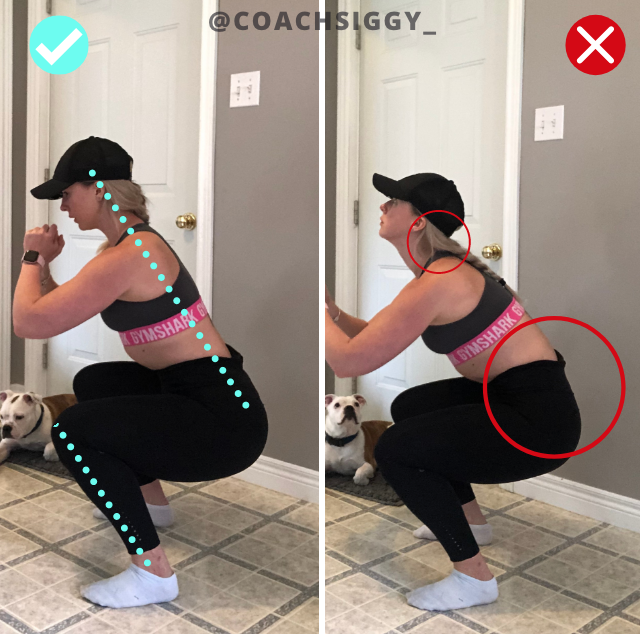FIX YOUR BACK SQUAT
The squat movement builds fundamental strength in our quads, glutes hamstrings and core. There’s many variations of a squat including dumbbell, front, banded, heels elevated, split squats and more. All squat variations are important in different goal scenarios. The back squat is considered king of squats, but it’s no more special than the rest. However, it does take a great amount of strength and practice!
Typically when you search “glute building workout” on Youtube, the screen will be flooded with exercises like bridges, donkey kicks, cable work and bands. Although, some of these movements are great choices in certain situations (beginner, rehab/prehab, connection), long term they wont help you build strong and big glutes. However, the reason these exercises become many people’s “go-to’s” is because you can really “feel the burn!”.
Feeling is not fact.
The burning feeling during exercise is not the best feeling to chase when the goal is muscle growth. When we’re building muscle, we need to be able to progressively overload the exercise. Progressive overload means increasing the intensity of the lift overtime. We can do this by adding weight to the barbell. It’s not mutually exclusive of “the burn”, but the focus is progressive overload, not feeling the burn. The barbell squat helps us load the bar indefinitely, which long term can help with progressive overload and therefore build muscle strength and size.
THE BACK SQUAT
FEET
Feet should be planted under the hips or slightly wider. The width of your stance can be based on your genetics. You should feel strong and stable in this position. A neutral stance (not too wide and not too narrow) will create a balanced squat using quads, glutes and hamstrings.
Toes can point forward or slightly out. Find what’s comfortable for you, this will be different for everyone and is based on mobility and genetics.
Spread your toes and grip the ground. This helps engage the glutes and core from the bottom up. It creates strong feet and healthy knees. If you have trouble gripping the floor then you may have weak feet. This can lead to a weak base of support and can cause issues upstream in the knees, hips, back. A trainer can help you strengthen your feet.
Now without lifting or moving your feet think about corkscrewing your feet out and into the ground to engage glutes like your trying to screw your feet down into the floor
Keep those toes planted while driving your heels down into the floor. If your heels lift when you squat, you may need to double down on your ankle mobility.
KNEES
Knees should track right over the laces
There should be NO wobble in your knees (in or out). If there is, we need to regress the variation back to goblet squat or dual dumbbell, or lower the resistance used until we have the strength to stay engaged and active in the glutes throughout the entire squat.
Don’t be afraid to let you knees track past your toes. Just remember, heels down!
HIPS
Hips should stay in a neutral position to prevent excessive arching in the low back. If excessive arching seems to be an issue for you, we may need to address ankle and/or upper back mobility and core stability.
We also don’t want the pelvis to tuck underneath at the bottom of the squat. This is a buttwink. It looks like “tucking your tails between your legs” like a scared dog. If this happens to you, try shortening your range of motion (for now). Stopping your descent just before your pelvis starts to tuck under and progressively work to get lower with a neutral pelvis.
Think of the pelvis as a bucket of water. If the pelvis tilts back (like a dog tucking their tail between its legs) all the water will spill out the back. If the pelvis tilts forward like a 'model on Instagram, the water will spill out the front.
Need clarification?
Hit play on the video below and practice the drill until you can move your pelvis on command.
DEPTH
When it comes to depth, the goal is to get as low as possible with control. A deeper squat means the more muscle used and more mobility in the joints,
What does “with control” mean?
Lack of pelvic stability (wink or extend), the chest collapsing forward, or loss of form on any of the keys mentioned above would be considered loss of control. Keep working on getting your squat deeper by trying to add an inch every time. A controlled and deep squat builds more muscle, strength and mobility than a heavy and shallow squat.
If you can’t get to 90 degrees in your squat (thighs parallel to floor) then try placing a box or bench under you. Aim to tap your butt onto the box each rep, slowly progress that box lower overtime.
UPPER BODY
Create tension in the core by taking a big breath down into the belly before lowering into the squat
Keep the ribs pinned down and don’t let them flare out and up
The back should remain flat with the chest lifted. If I am standing in front of you I should be able to read your t-shirt!
From the side angle the shins and back run on parallel lines (see image above)
Remember the neck is part of the spine, take your gaze about 3 meters out in front of you on the floor. Rather then cranking the neck up and looking at the ceiling


